 y.layout.tree.TreeMapLayouter
y.layout.tree.TreeMapLayouter
|
Search this API | ||||||||
| PREV CLASS NEXT CLASS | FRAMES NO FRAMES | ||||||||
| SUMMARY: NESTED | FIELD | CONSTR | METHOD | DETAIL: FIELD | CONSTR | METHOD | ||||||||
java.lang.Objecty.layout.tree.TreeMapLayouter
public class TreeMapLayouter
This layout algorithm produces tree map layouts.
Tree maps are suitable to visualize hierarchical data structures. They use nested rectangles to do so, where the size of the rectangles encodes its weight. More generally, the area of a rectangle is proportional to a specific dimension of data associated to it.
Tree maps can, for example, be used to show a file structure on a hard disk, where the dimension of data is the size of the files/folders. There are many other use cases where the tree map can show the distribution of the dimension of data among the entities in a hierarchy.
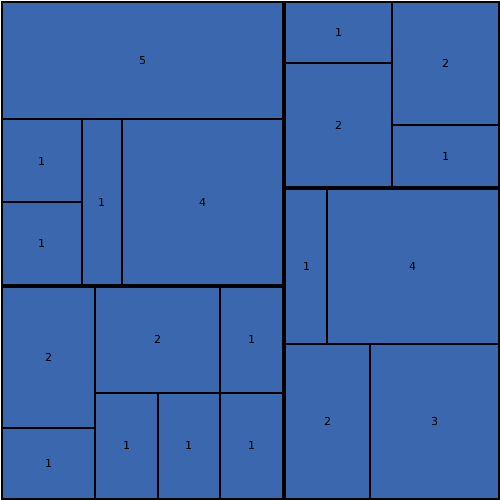
A tree map with four different sub-groups - node labels define the weight; note that there are no edges in a tree map
TreeMapLayouter offers implementations of the well-known treemapping-algorithms
Slice-and-Dice and Squarified.
These tiling policies divide a rectangle with a given size into multiple sub-rectangles.
Speaking in terms of graphs this means that nodes are placed in a nested fashion such that child nodes
are placed inside the parent node.
Importantly, node sizes are changed by this layout algorithm to show the proportional weight of
a node in the map. The weight is specified by registering a DataProvider with
key NODE_WEIGHT_DPKEY with the input graph.
The input can be specified in two ways:
GroupingKeys.GROUP_NODE_INSETS_DPKEY). If the
graph is a tree graph, then the grouping structure is ignored - see second input variant.
To continue using the hierarchy information of the grouping structure on a tree graph, one can
temporarily hide the tree edges before running the layout.
Trees.directTree(Graph, Node). The tree needs to be directed from the root (top-level
hierarchy) to the children (lower-level hierarchies). Note that a forest graph is no valid input.
The offered tiling policies produce drawings with a quite different style.
TILING_POLICY_SLICE_AND_DICE offers results that have a stable, clear ordering but the rectangles
have a high aspect ratio. On the other hand, TILING_POLICY_SQUARIFIED tries to create rectangles
close to a given aspect ratio - in consequence, the ordering of neighbor nodes might not be clearly predictable.
weights is large, i.e., a large difference
between the minimum and maximum weight value, then the resulting tree map might become really large,
making readability bad. The reason is that the relative weight differences need to be considered
while still satisfying the minimum node size for the nodes with low weight.
A solution would be to scale/interpolate the weight values before running the layout.spacing, nodes that have the same actual
weight can get slightly different sizes - especially if they are on different hierarchy levels.
This is necessary to satisfy the specified distances and insets.
If exact same sizes throughout hierarchies is a requirement, set the
spacing to 0 and do not specify
insets for the group nodes that have children (if input is specified as grouping structure).NodeHalos assigned to nodes.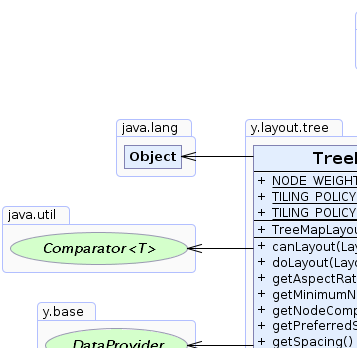 |
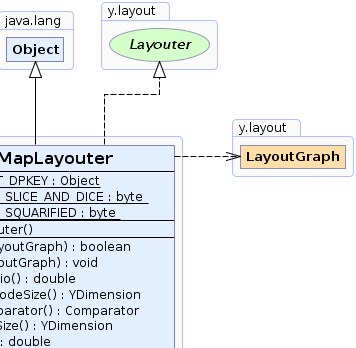 |
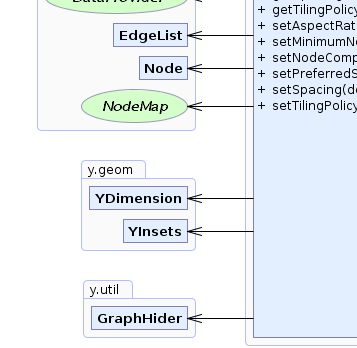 |
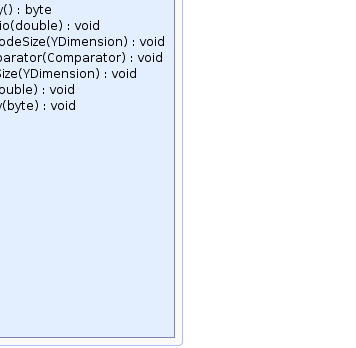 |
| Nested Class Summary | |
|---|---|
static class |
TreeMapLayouter.NodeWeightComparator
A Comparator that compares two nodes with respect to their weight value defined
via the DataProvider registered with NODE_WEIGHT_DPKEY. |
| Field Summary | |
|---|---|
static java.lang.Object |
NODE_WEIGHT_DPKEY
A DataProvider key for specifying the weight of the nodes.
|
static byte |
TILING_POLICY_SLICE_AND_DICE
A tiling policy that places the child nodes one after another inside the parent node. |
static byte |
TILING_POLICY_SQUARIFIED
A tiling policy that uses the so-called 'squarify' algorithm. |
| Fields inherited from interface y.layout.Layouter |
|---|
EDGE_ID_DPKEY, NODE_ID_DPKEY, NODE_TYPE_DPKEY, SELECTED_EDGES, SELECTED_NODES |
| Constructor Summary | |
|---|---|
TreeMapLayouter()
|
|
| Method Summary | |
|---|---|
boolean |
canLayout(LayoutGraph graph)
Accepts all graphs. |
void |
doLayout(LayoutGraph graph)
Arranges the given input graph as a tree map. |
double |
getAspectRatio()
Returns the target aspect ratio of the squarified tiling policy. |
YDimension |
getMinimumNodeSize()
Returns the minimum size (height and width) a node in the tree map must have. |
java.util.Comparator |
getNodeComparator()
Returns the TreeMapLayouter.NodeWeightComparator that defines the order in which child nodes are placed inside their parent node. |
YDimension |
getPreferredSize()
Returns the desired dimension of the root rectangle into which all nodes are placed. |
double |
getSpacing()
Returns the spacing between nodes of the same hierarchy. |
byte |
getTilingPolicy()
Returns the tiling policy that defines how the input is divided into sub-rectangles. |
void |
setAspectRatio(double aspectRatio)
Specifies the target aspect ratio of the squarified tiling policy. |
void |
setMinimumNodeSize(YDimension minimumNodeSize)
Specifies the minimum size (height and width) a node in the tree map must have. |
void |
setNodeComparator(java.util.Comparator comp)
Specifies the TreeMapLayouter.NodeWeightComparator that defines the order in which child nodes are placed inside their parent node. |
void |
setPreferredSize(YDimension preferredSize)
Specifies the desired dimension of the root rectangle into which all nodes are placed. |
void |
setSpacing(double spacing)
Specifies the spacing between nodes of the same hierarchy. |
void |
setTilingPolicy(byte tilingPolicy)
Specifies the tiling policy that defines how the input is divided into sub-rectangles. |
| Methods inherited from class java.lang.Object |
|---|
clone, equals, finalize, getClass, hashCode, notify, notifyAll, toString, wait, wait, wait |
| Field Detail |
|---|
public static final java.lang.Object NODE_WEIGHT_DPKEY
DataProvider key for specifying the weight of the nodes.
The weight of a node defines the area assigned to the node inside the available parent area with respect to the other child nodes. Child nodes with the same weight get the same area, they do not necessarily get equal width and height values.
All leaf nodes (nodes without further children, including empty group nodes) must have a weight
greater than 0.
Non-leaf nodes do not need to have a weight. They will basically get the sum of the weight of their
children. If they have a weight on their own, some free space is generated inside the
representative rectangle (i.e. the parent node is larger than the combined children).
getSpacing(), nodes that have the same actual
weight can get slightly different sizes.public static final byte TILING_POLICY_SQUARIFIED
It tries to generate nodes with a size close to a specified
aspect ratio. This increases the readability of the tree maps.
The child ordering given by getNodeComparator() is considered but it is not as predictable
as for TILING_POLICY_SLICE_AND_DICE. The order is not strictly from top to bottom or from
left to right, but it might differ for different subsets of children. This is an inherent part
of the squarified procedure.
The implementation follows the approach of Bruls et al. [Bruls, Mark; Huizing, Kees; van Wijk, Jarke J. (2000). 'Squarified treemaps'].
public static final byte TILING_POLICY_SLICE_AND_DICE
Child nodes are either tiled vertically (slice), one on top of the other with the width equal to the parent's width. Or they are tiled horizontally (dice), one next to the other with the height equal to the parent's height. The tiling strategy alternates with the hierarchy levels, e.g., level 1 uses slice, level 2 uses dice, level 3 uses slice and so on.
This policy keeps the ordering of the children defined by getNodeComparator() stable. Either children
are strictly ordered from left to right (dice) or from top to bottom (slice).
| Constructor Detail |
|---|
public TreeMapLayouter()
| Method Detail |
|---|
public byte getTilingPolicy()
setTilingPolicy(byte)public void setTilingPolicy(byte tilingPolicy)
TILING_POLICY_SQUARIFIEDtilingPolicy - the tiling policy that should be used
java.lang.IllegalArgumentException - if an unknown policy is specifiedpublic java.util.Comparator getNodeComparator()
TreeMapLayouter.NodeWeightComparator that defines the order in which child nodes are placed inside their parent node.
TreeMapLayouter.NodeWeightComparator that defines the node ordersetNodeComparator(Comparator)public void setNodeComparator(java.util.Comparator comp)
TreeMapLayouter.NodeWeightComparator that defines the order in which child nodes are placed inside their parent node.
TreeMapLayouter.NodeWeightComparator. Nodes are ordered with respect to their weight (higher weight first).comp - the TreeMapLayouter.NodeWeightComparator that defines the node order
java.lang.IllegalArgumentException - if the given TreeMapLayouter.NodeWeightComparator is nullpublic YDimension getMinimumNodeSize()
If the weight data induces that a node would get a width/height smaller than
specified by the minimum size to fit into the preferred size, then the output
size will be increased until all nodes fulfill the minimum size requirement.
This scenario will mostly occur if the weights of nodes have a large range or if the specified preferred
output size is small.
setMinimumNodeSize(YDimension)public void setMinimumNodeSize(YDimension minimumNodeSize)
If the weight data induces that a node would get a width/height smaller than
specified by the minimum size to fit into the preferred size, then the output
size will be increased until all nodes fulfill the minimum size requirement.
This scenario will mostly occur if the weights of nodes have a large range or if the specified preferred
output size is small.
YDimension. Minimum width and height are 10.0.minimumNodeSize - the minimum node size
java.lang.IllegalArgumentException - if the width or height of the given size is smaller than 5
or if the given minimum size is nullpublic YDimension getPreferredSize()
If it is possible to arrange all nodes such that they fit into the preferred size, then the
final result will exactly have this size. However, satisfying the specified
spacing and minimum node size has higher priority.
This means that the final output might become larger if necessary. On the other hand, it will never be
smaller, even if it would be possible to generate a smaller result.
setPreferredSize(YDimension)public void setPreferredSize(YDimension preferredSize)
If it is possible to arrange all nodes such that they fit into the preferred size, then the
final result will exactly have this size. However, satisfying the specified
spacing and minimum node size has higher priority.
This means that the final output might become larger if necessary. On the other hand, it will never be
smaller, even if it would be possible to generate a smaller result.
YDimension. Preferred width and height are 600.preferredSize - the preferred size of the root rectangle
java.lang.IllegalArgumentException - if the given size is null or if its width/height value is
less than or equal to zeropublic double getAspectRatio()
squarified tiling policy.
The aspect ratio must be greater than or equal to 1. A ratio of 1 means that
the node rectangles should ideally be squares. The orientation of the rectangles does not matter. For example,
a ratio of 2 means that rectangles with an aspect ratio of 1:2
or also 2:1 are desired.
This setting affects the ratio of a single node rectangle. To create a tree map with a certain overall aspect
ratio, the preferred size can be specified accordingly.
TILING_POLICY_SQUARIFIED is specified as
tiling policy.setAspectRatio(double),
TILING_POLICY_SQUARIFIEDpublic void setAspectRatio(double aspectRatio)
squarified tiling policy.
The aspect ratio must be greater than or equal to 1. A ratio of 1 means that
the node rectangles should ideally be squares. The orientation of the rectangles does not matter. For example,
a ratio of 2 means that rectangles with an aspect ratio of 1:2
or also 2:1 are desired.
This setting affects the ratio of a single node rectangle. To create a tree map with a certain overall aspect
ratio, the preferred size can be specified accordingly.
TILING_POLICY_SQUARIFIED is specified as
tiling policy.aspectRatio - the target aspect ratio for the squarified tiling policy
java.lang.IllegalArgumentException - if the given aspect ratio is smaller than 1TILING_POLICY_SQUARIFIEDpublic double getSpacing()
This spacing enables to insert a padding between all nodes/rectangles on the same hierarchy. It is not inserted between a group node (border) and its children - use group node insets for that use case.
setSpacing(double)public void setSpacing(double spacing)
This spacing enables to insert a padding between all nodes/rectangles on the same hierarchy. It is not inserted between a group node (border) and its children - use group node insets for that use case.
public boolean canLayout(LayoutGraph graph)
To create meaningful tree maps, the graph should either contain hierarchical grouping information or be a tree graph that defines the hierarchy.
canLayout in interface Layoutergraph - the input graph
true for all graphsLayouter.doLayout(LayoutGraph)public void doLayout(LayoutGraph graph)
To create meaningful tree maps, the graph should either contain hierarchical grouping information or be a tree graph that defines the hierarchy.
doLayout in interface Layoutergraph - the input graphLayouter.canLayout(LayoutGraph)
|
© Copyright 2000-2025, yWorks GmbH. All rights reserved. |
||||||||
| PREV CLASS NEXT CLASS | FRAMES NO FRAMES | ||||||||
| SUMMARY: NESTED | FIELD | CONSTR | METHOD | DETAIL: FIELD | CONSTR | METHOD | ||||||||